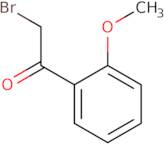2-Bromo-1-(2-methoxyphenyl)ethanone
CAS: 31949-21-0
Rif. 3D-FB144355
| 5g | Fuori produzione | ||
| Dimensione non definita | Fuori produzione | ||
| 10g | Fuori produzione | ||
| 25g | Fuori produzione | ||
| 50g | Fuori produzione | ||
| 100g | Fuori produzione |
Informazioni sul prodotto
- 1-(2-Methoxyphenyl)-2-bromoethanone
- 2-(Bromoacetyl)anisole
- 2-Bromo-1-(2-Methoxyphenyl)Ethanone
- 2-Bromo-1-(2-methoxyphenyl)ethan-1-one
- 2-Bromo-2-Methoxyacetophenone
- 2-Methoxyphenacyl bromide
- 2′-Methoxy-2-bromoacetophenone
- Acetophenone, 2-bromo-2′-methoxy-
- Bromo-2′-methoxyacetophenone
- Bromomethyl 2-Methoxyphenyl Ketone
- Vedi altri sinonimi
- Bromomethyl o-methoxyphenyl ketone
- Ethanone, 2-bromo-1-(2-methoxyphenyl)-
- alpha-Bromo-2'-methoxyacetophenone
- o-Methoxy-2-bromoacetophenone
- o-Methoxyphenacylbromide
- α-Bromo-2-methoxyacetophenone
- ω-Bromo-2-methoxyacetophenone
2-Bromo-1-(2-methoxyphenyl)ethanone (2-BMEE) is an antibacterial agent that belongs to the benzofuran class of compounds. It has been shown to be a potent inhibitor against both Gram-positive and Gram-negative bacteria. 2-BMEE was first synthesized in 1958, and is still used as an antibacterial agent in some countries today. The synthesis of 2-BMEE involves two steps: 1) the synthesis of phenacyl bromide and 2) the quaternization of phenacyl bromide with dimethylamine. The crystallization process for this compound is efficient, and it can be produced in large quantities at a low cost.
2-BMEE inhibits bacterial growth by binding to the pyridinium ring of DNA gyrase, inhibiting DNA replication and transcription. This inhibition prevents the production of new proteins, causing cell death by apoptosis or nec





